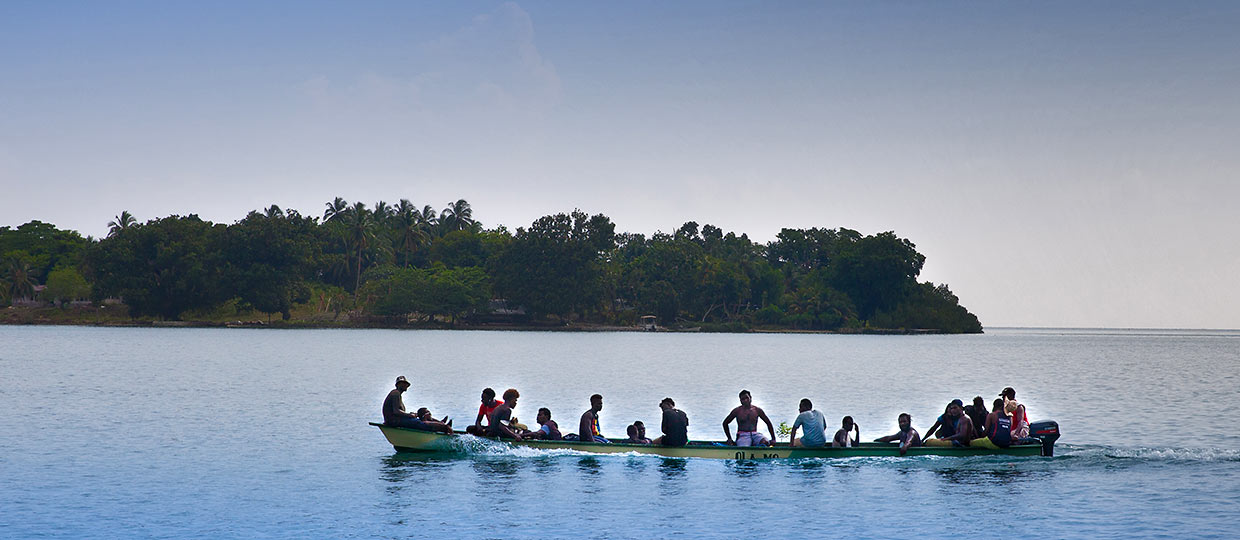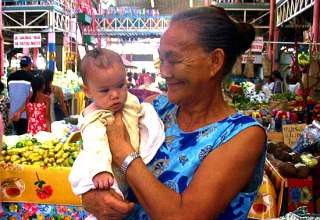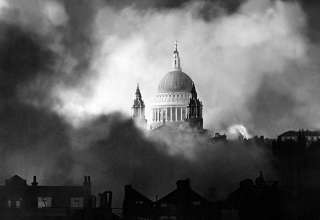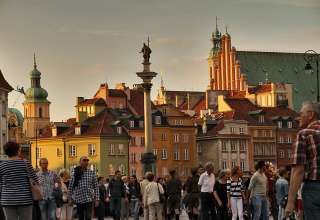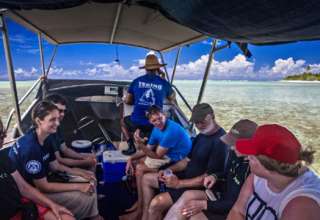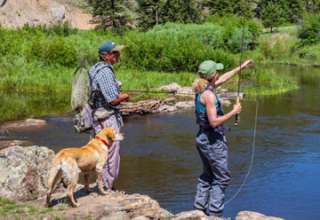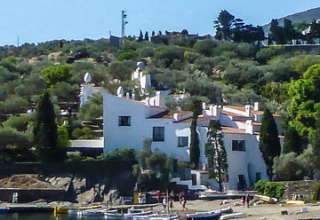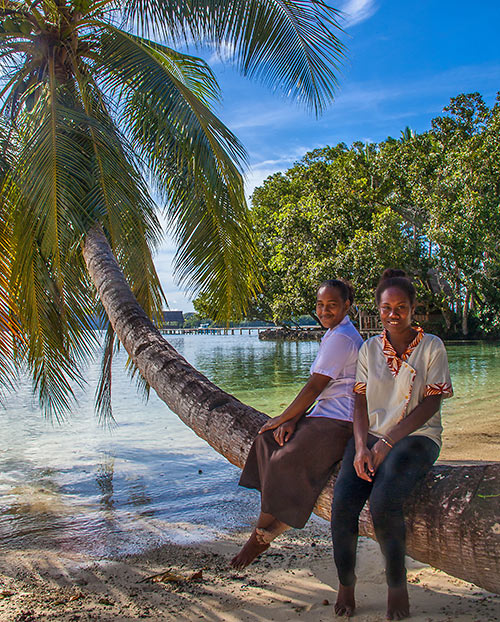
HONIARA, Solomon Islands — If it weren’t for the potholes, thousands of gaping pits jolting the car every which way, I wouldn’t have missed the sign on the tree. But Andrew, our guide on Guadalcanal, in the Solomon Islands, knew everybody. “That’s Dolphin View Cottage and there’s the owner,” he said, waving at a stocky, dark-skinned man in rumpled shorts, a faded t-shirt and flip flops. “It’s Guyas Tohabellana. He works here in Honiara. C’mon, let’s say hello.”
Down by the shore, Guyas’s son Mike sat at a picnic table with his sister, playing with his pet cockatoo. Behind them the beach sloped down to Iron Bottom Sound, the World War II graveyard where 50-plus sunken ships — American and Japanese — still rest, slowly rusting away. Across the water, Savo Island, site of the famously fierce WWII batle, shimmered on the horizon. For a minute the two men chatted, speaking local Pijin so quietly I missed most of it. Then Guyas turned to me and held out his hand. “You’re from America!” he said, beaming. “Do you like it here? Have you been to Gizo and seen the beautiful coral reefs? Yes, my grandfather was a Coast Watcher during the war, a spy you’d say, reporting Japanese movements to the Americans. He watched the Battle of Savo Island from right here.”
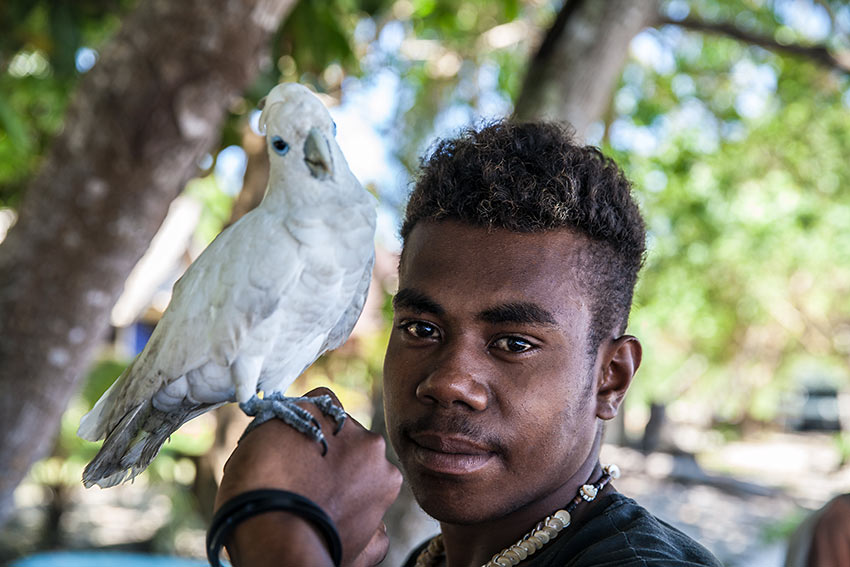
Arriving for a two-week trip in early 2019, we were lucky to be there before the corona virus became a pandemic and the country closed its borders. Two of just 25,000 annual tourists — fewer than on a single day at DisneyWorld — we seemed to be the only Americans there. But we did want to see some of Guadalcanal’s famous battle sites, rusty tanks, long-buried artillery and the remains of downed airplanes. In 1942, when the first company of American Marines landed on Guadalcanal, the local islanders joined the fight, supporting the troops as eyes on the ground. Allies then, American tourists still friends, invariably greeted with an exchange of names and a handshake. “Americans are always welcome,” said manager Ellison Kyere, from the tourism office in Honiara, the capital city, when my partner Steve and I met him for lunch at the Lime Lounge Café. “But we want them to know that there’s more to see here than battle sites and more to do than scuba dive for wrecks. We have mountains that have never been climbed, natural preserves, miles of beaches, lagoons, forests and rare birds.”
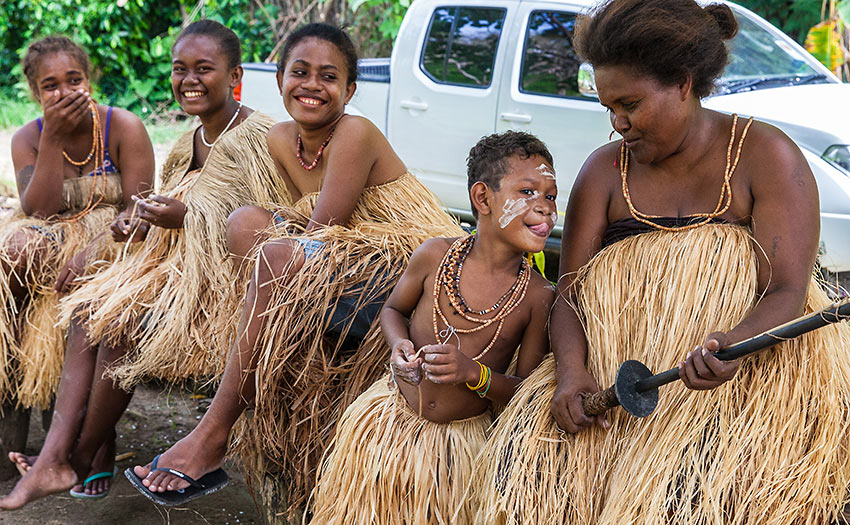
Planning a trip beyond Honiara is a tall order in this South Pacific nation, 2039 miles northeast of Australia. With 922 islands, three-fifths of them uninhabited, it’s a hodge-podge of many cultures, dozens of traditions and 78 different languages. The website is a good place to start, at www.visitsolomons.com.sb. But there’s no hurry. With no covid19 cases reported as of July 1, 2020, the borders are closed and international flights are cancelled.

When it comes to picking a flight, Fiji Airways’ non-stop, overnight flights from Los Angeles are our first choice. The airline’s gleaming new plane — an Airbus A350-XWB — has private beds in the front and big seats in the rear, with an overnight flight that lets you sleep. We arrived early enough for a second breakfast in Fiji’s Nadi airport and plenty of time to board the Solomon Airlines three-hour flight to Honiara. On arrival, I took advantage of the “tourist special,” a SIM card good for 75 minutes, priced at U.S. $1.30. The rest of the day we spent in the Heritage Park Hotel garden and pool, and booked a tour for the next day.
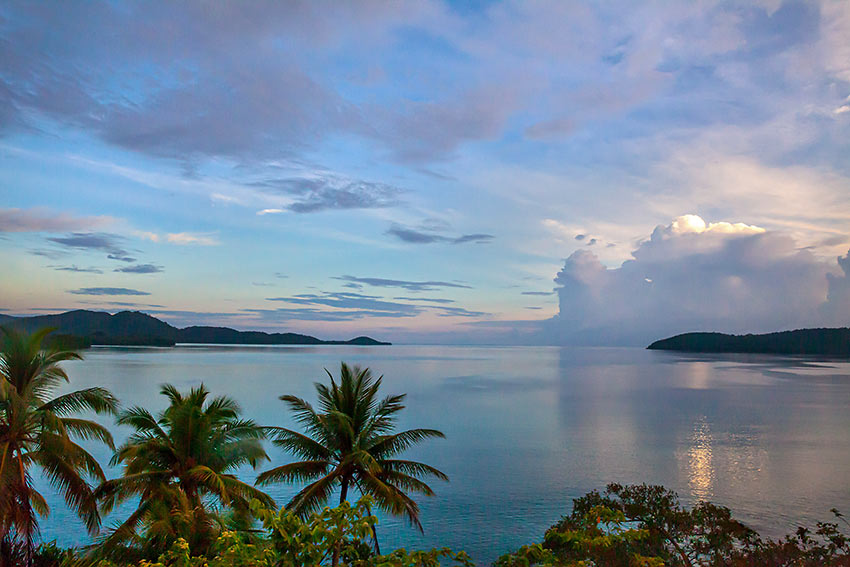
We were still jetlagged when Andrew pulled up the next morning, driving a two-year-old, shiny black SUV. I was impressed but he apologized. “All our cars are Japanese and they’re all second-hand. We never get new ones,” he said. “Never. And see this? The Japanese are building the overpass and paving the street and it’s taking forever,” he added, as we inched past grimy storefronts and vegetable stands overflowing with greens, tomatoes and squash. “That new one, where everybody shops, is owned by a Chinese company,” he said, nodding at a big-box department store, the kind China builds in every willing mineral-rich third-world country. We’ve seen these “gifts” before. They are there to smooth the way for future highway and mining contracts.
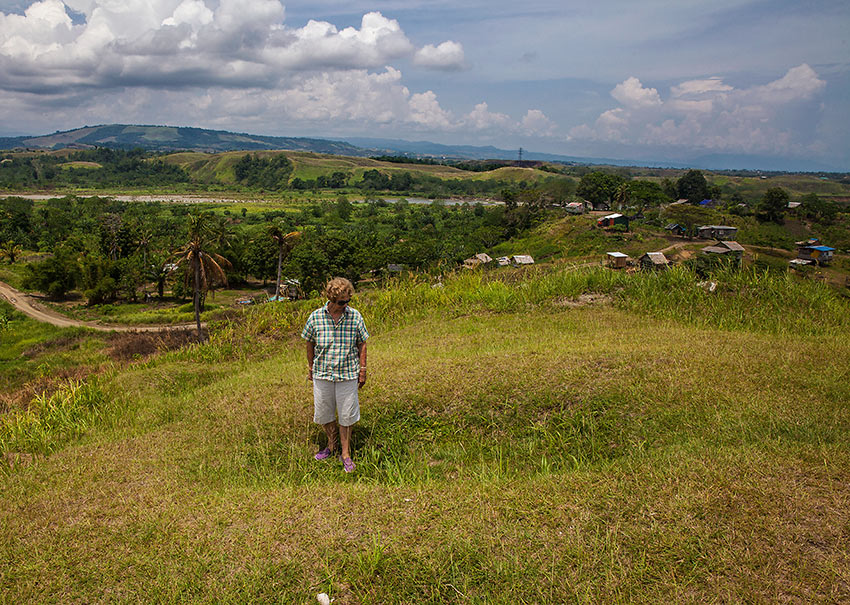
Mortified, I looked for something I could brag on — an American-built hospital or a college — but Andrew had already turned toward the American Memorial Garden, the cemetery and then to Bonegi Beach to see a rusty tank. Then we headed to up the hills to Bloody Ridge, where Andrew parked, leaving a few minutes to walk past the row of overgrown foxholes and imagine the deafening noise and chaos as the Japanese rushed up from below and were beaten back. I wondered who they were, the 40 U.S. Marines who died here.
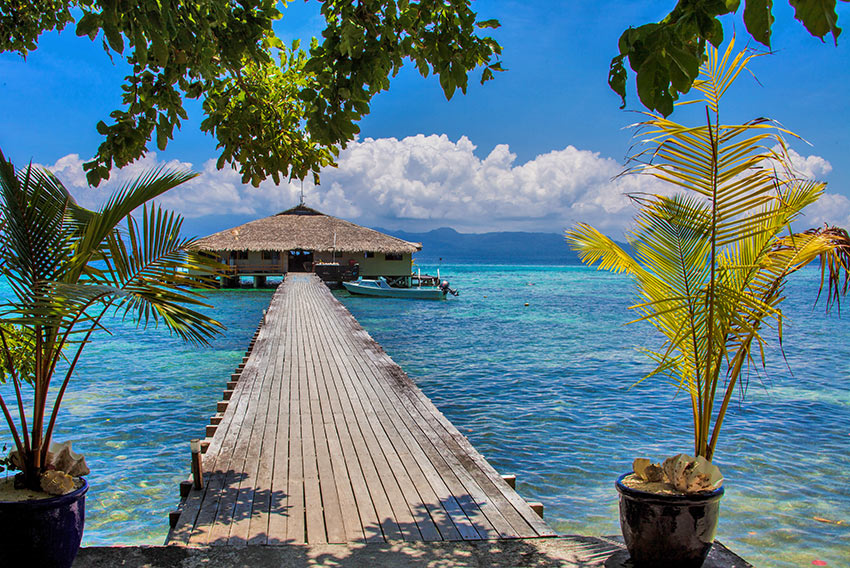
After touring Guadalcanal, we flew we flew north to a one-room water-side airport on Gizo, on Ghizo Island and then to Munda, on New Georgia, in the Western Province. The gateway to pristine rain forests, volcanic mountains, blue lagoons and sandy beaches, the Western Province was made for adventurers. Meeting our driver and a Fat Boys motor boat, we hopped aboard and in minutes we were speeding away over a clear blue lagoon to the dock.
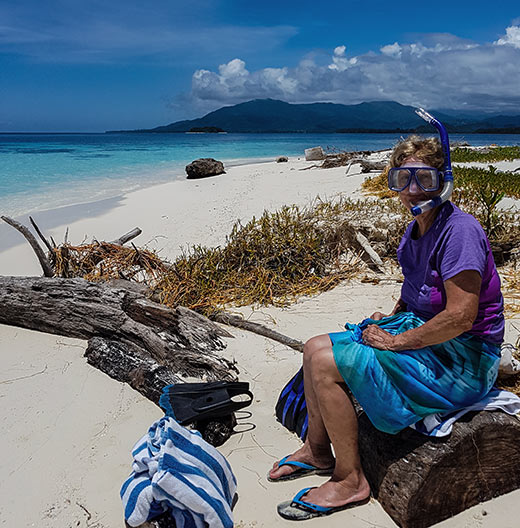
Fat Boys Resort, our base camp for three nights, was located on a small island, in a group of smaller islets near easy-to-reach tour sites. The first was Kennedy Island (also called Plum Island), where Lieutenant John Kennedy and his PT-109 crew swam ashore after a Japanese vessel sank their torpedo boat. After a look around — and a quick swim — we headed away to another group of islets and sand bars, for a lobster barbecue and snorkeling. “The ocean is washing the island away,” said Sam, the boat captain, as he stowed the ice chest and a grill under a shady tree. “Why do these trees, with half of their roots in salt water, seem to be dying,” I’d asked. “People around here used to think they had a disease,” he said. “Now everybody knows why. It’s global warming.”
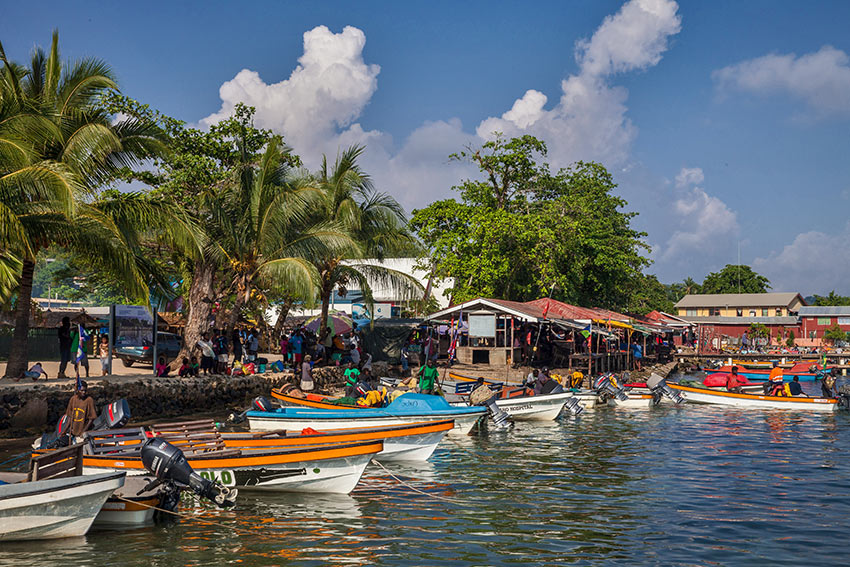
It was party time the next day in Gizo, the main town on Ghizo Island, at the Friday market. Families in home-made dugout canoes docked at the waterfront, buyers crowded the aisles, coins changed hands, sellers hailed friends and old ladies filled their shopping bags. Everyone smiled, asking where we were from and offering to pose for photos. Ngali nuts — the holy grail of island snacks — were in season so I stocked up with a half-dozen packages in folded-leaves. Green taro leaves competed with slippery spinach (Malabar spinach), purple bananas, four or five kinds of potatoes, carrots and betel nuts, a popular and affordable substitute for coffee or cigarettes. “What do they taste like?” I asked an older man with red-rimmed eyes (the give-away), who offered me a seat in the shade. “Do they make you feel relaxed?” I ventured to ask.
“Oh, no, they give you energy!” he said, smiling, showing me how to fold the nut and leaf together with a pinch of slaked lime (ash from burned clam shells). “One or two of these and I want to get up and work all day.”
Flying on to Munda, famous for wreck diving, we checked into the Agnes Gateway Hotel on the waterfront, a group of rooms and spartan cottages advertised in scuba and backpacking magazines. Our cottage was beyond plain but it had a front porch with chairs, and hooks and a clothes line for bathing suits and diving gear. The restaurant and bar, conveniently adjacent to the check-in desk, served hearty, tasty affordable meals. Booking a boat tour out to Skull Island — the last stop for many a victim — now a popular tourist highlight — we joined captain Billy Kere, 40-ish and friendly, and as he introduced himself, a “descendant of the Roviana headhunter clan.” Once past the coral, Kere cranked up the speed and we roared out over the deep water for 45 minutes, the bow pounding the waves until we reached the island, a small pile of slippery rocks and sharp coral (wear tennis shoes). The skulls inside this gloomy cavern were piled high on every side, with more on a small altar, near a cement plaque where — where it is said — the headhunters buried a well-intentioned but unlucky Christian minister.
“Don’t worry, the headhunters are gone,” said Billy, chuckling. “Nowadays it’s all about love. But not then. If you sinned, your head came off.” Heading out, we docked at Lubaria Island, a public park and the PT-boat base where Lieutenant Kennedy and his crew were stationed during the war. The barracks and a new modern bathroom were open and several rusty artillery pieces remained, half-hidden in the bushes, facing out to sea. But a new monument stood in the center, guarded by Ata, the park’s ancient keeper, who lives in a tent near the pier. Hustling over to us, he produced a carved wood bust of the youthful Kennedy which belongs on the monument but which he hides at night. “It’s been stolen and recovered twice,” he said, as we snapped photos.
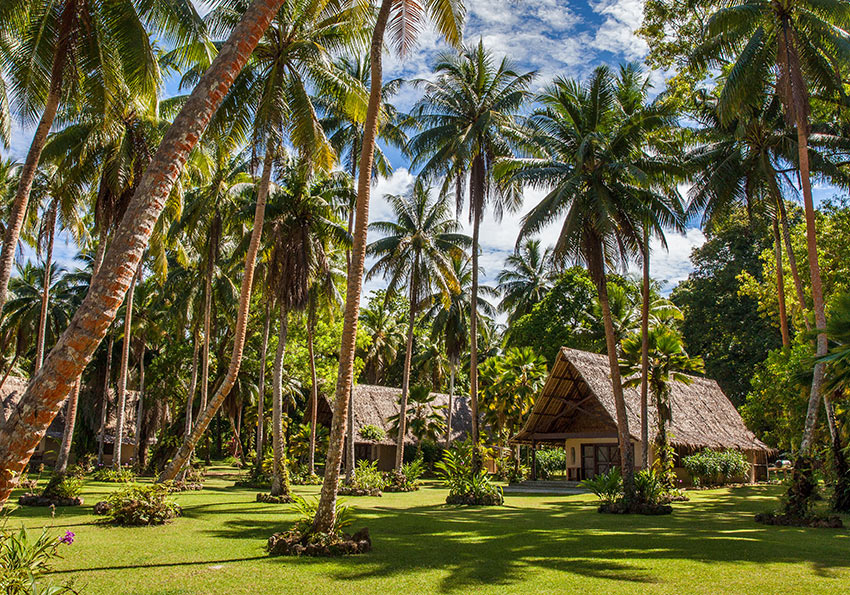
As the trip wound down, we headed for Tavanipupu Island Resort and Spa, one of the Solomons’ few five-star properties. Installed in the same palm-shaded bungalow where England’s Will and Kate overnighted on a previous world tour, we reveled in the screened windows, four-poster bed, indoor and outdoor showers, two sinks and a covered porch, a perfect place to watch the sunset. We swam off the dock in water so clear we could see 20 feet down, canoed (with a guide) over acres of healthy coral, sampled the chef’s summer menu, climbed the hill for a view and walked around the perimeter, an easy 45-minute stroll.
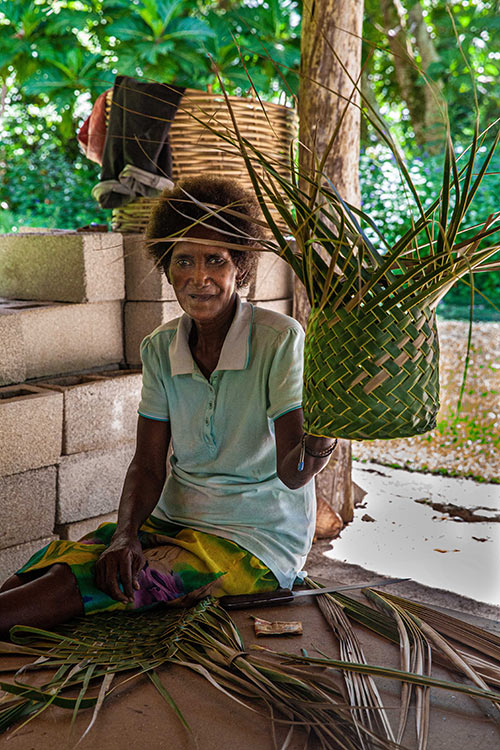
On our own to explore, we met some of the local islanders, a chance to learn more about everyday life on an outlying island: Finding fresh water, doing laundry, picking coconuts, planting vegetables, making canoes, uses of native trees, the names of other islands, and favorite foods. When I asked who made the woven baskets in our room, I was introduced to Melania who paddles to work from her home on an adjacent island. Finding her in the laundry, an open-air platform behind the lodge, furnished with soap and water, outdoor tubs and an improvised washboard, she put the washing aside for 15 minutes to show me how to split and strip the leaves from sego palms, then weave them together. Before we left, the manager joined us for dinner, and asked what we thought what most Americans liked to do, besides swimming and sunning. We suggested a couple of inexpensive and low maintenance games: croquet, tether ball and the corn-hole toss. To my surprise, he’d never heard of any of them, hence a comic evening enlivened by charades.
At last, with two weeks gone and our trip at an end, we boarded a Twin Otter — lifting off a grassy field — for the flight back to Honiara. Soaring over islands, bays, coral reefs, mountains, rain forests, volcanoes, winding rivers, broad estuaries and waterfalls — I realized how much we’d missed. The Solomon Islands, unspoiled and spectacular, is one of the world’s last untamed destinations. The roads need work, but those ghastly potholes might be just what’s keeping the uncurious away. Potholes or not, we’re going back.
©Anne Z. Cooke, The Syndicator 2020.
